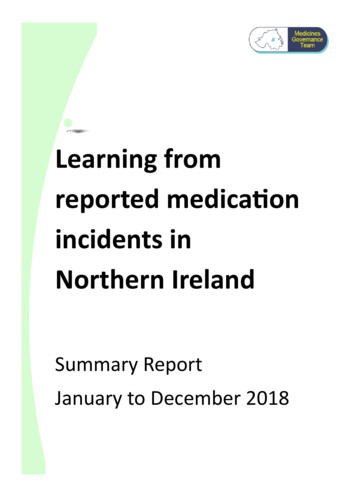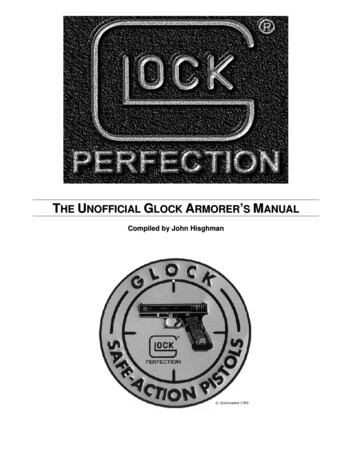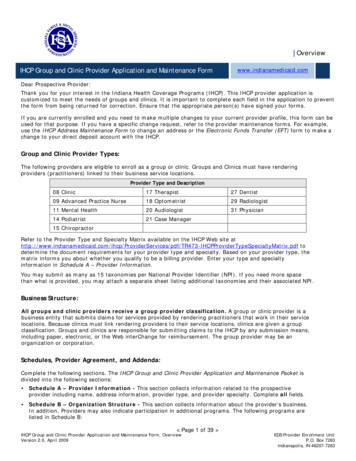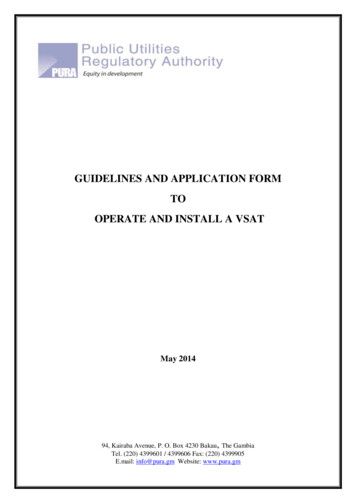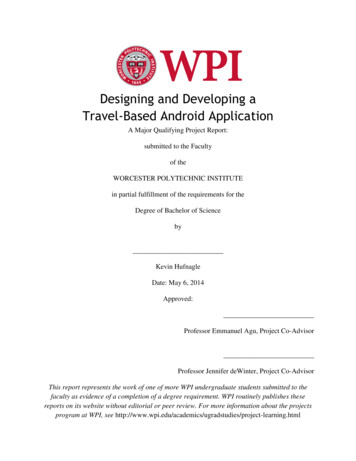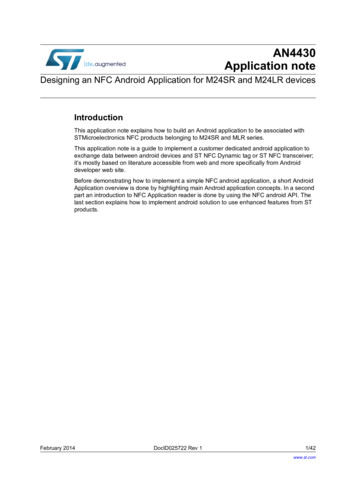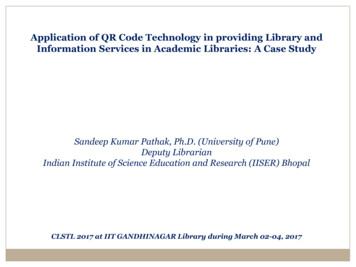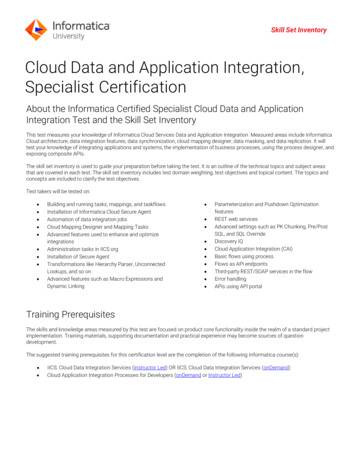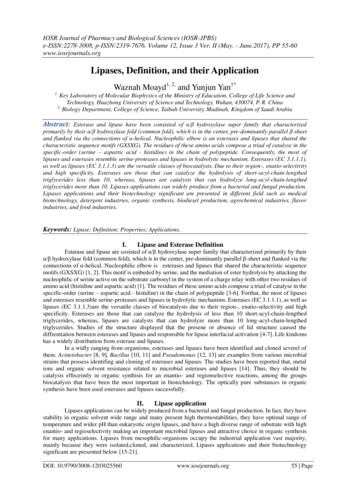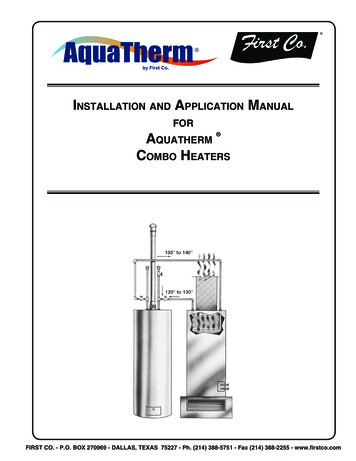
Transcription
Installation and Application ManualforAquatherm Combo HeatersFIRST CO. - P.O. BOX 270969 - DALLAS, TEXAS 75227 - 1Ph. (214) 388-5751 - Fax (214) 388-2255 - www.firstco.com
Table of ContentsPageIntroduction3Sequence of Operation 3General Description:Air handler cabinetHeating and cooling coilsAdd-on hot water coilCirculating pumpFlow control moduleCheck valveAir purge valveBlower door safety switchWater heaterBoiler3333334444Accessories:Thermostat 4Freeze protector 4Equipment Sizing:Condensing unit 4Air handler 4Water heater 5Installation:Duct workElectricalWater piping1. Material2. Solder connections3. Insulation4. Length5. Shut-off valves6. Piping connectionsAir handlerFlow control moduleWater heaterMultiple water heatersAnti-scald valve556666666,8-1066677Start-up Procedure (heating cycle) 7Troubleshooting 122
The Aquatherm is a First Co. air handler thatconverts a properly sized gas or oil-fired water heaterinto a highly efficient, dual - purpose appliance thatcan heat your home as well as provide hot water fordomestic purposes.Any properly sized water heater (for heating) andsplit system type condensing unit (for cooling) willwork with First Co. Aquatherm air handlers andare to be supplied by others. NO SPECIAL WATERHEATER IS REQUIRED!Add - on hot water coil: First Co. HWC series add-onhot water coils are designed to be installed in eitherexisting or new duct work and operate in conjunctionwith the existing fan motor to provide complete orsupplemental space heating from a gas or oil - firedwater heater. These coils are completely cased andutilize the separate “flow control module” which canbe installed at the water heater for easy access andservice (see “flow control module”).Circulating pump: All circulating pumps circulatewater at a rate of 3 to 6 gallons per minute and areeither factory installed or included as part of the fieldinstalled “flow control module”. These pumps aredesigned to circulate a precise amount of hot waterbetween the water heater and air handler or add - oncoil.Aquatherm air handlers are even compatiblewith boiler systems.Aquatherm air handlers include a fan motor forair circulation, hot water circulating pump, hot waterheating coil, air purge valve, check valve, components for low voltage control and most include acooling coil for air conditioning. All components in thewater piping meet NSF61 and/or california AB1953requirements.Flow control module: This U.L. Listed device consists of the circulating pump, check valve, air purgevalve, 6' plug - in line cord and pump relay. Themodule is sold & shipped separately with HWC add- on hot water coils. The module can be field installedanywhere in the hot water heating loop between thewater heater and hot water coil and offers the advantage of being able to install the pump assembly inthe most appropriate location for service and maintenance. Modules must be installed with the motorin a horizontal position. Junction box should not belocated underneath the pump.SEQUENCE OF OPERATION(Heating mode)When space heating is needed, the wall thermostatenergizes a small pump which circulates hot water(135 to 140 degrees ) from the water heater to the hotwater coil in the air handler. As the fan motor forcesthe cool return air from the home over the hot watercoil, the air absorbs heat from the hot water and thiswarm air (about 105 to 110 degrees) is then circulatedthroughout the duct system and into the home.IMPORTANT. . . . . in most applications the water willlose only 15 to 25 degrees in temperature while circulating through the hot water coil and will RETURNto the water heater at about 115 to 125 degrees tobe reheated.FLOW CONTROL MODULE - WIRING DIAGRAMGENERAL DESCRIPTIONAir handler cabinet: Air handlers with cabinets aremade of galvanized steel and fully insulated to reducenoise and maximize efficiency. Throwaway filters arefactory installed in most air handlers.Heating and cooling coils: All heating and coolingcoils are made of copper tubes with mechanicallybonded aluminum fins for maximum heat transfer.Manual air vents are included on all hot water coils.Cooling coils have either piston - type metering devices or field installed expansion valves. Primaryand secondary condensate drain connections areprovided on each cooling coil. All primary connectionsare 3/4 inch MPT.Check valve: A check valve is factory installed inthe hot water loop to eliminate any thermosyphoning(hot water circulating through the heating coil) whileoperating in the cooling mode. The check valve isinstalled within the air handler or as part of the “flow3
All other air handlers require a 24 volt thermostatthat energizes the fan motor on a requirement for cooling and heating. This is commonly called an "electricheat" thermostat. CAUTION . . . . . a gas furnacethermostat will NOT work with these units becausethe fan motor will not come on when the thermostatcalls for heat.Normal heat anticipator setting should be 0.3 to 0.4.If a set-back thermostat is used, allow extra time forrecovery in the morning.Freeze protector: Kit number 941-1 can be fieldinstalled on any Aquatherm air handler or add -oncoil and is highly recommended when the air handleror hot water coil is installed in a space that may besubjected to freezing temperatures such as in an atticor crawl space. The sensor attaches to the hot watercoil and is wired to R and W in the low voltage circuit.If for any reason the temperature of the hot water coilfalls below 38 degrees the sensor will bring on thepump to circulate hot water. This will occur even ifthe thermostat is in the "off" position.control module”.Air purge valve: All air handlers and / or “flow controlmodules” include a large manual air purge valve tofacilitate air removal from the heating loop prior tosystem start - up. When the air handler and waterheater are piped according to First Co. instructions,the air in the hot water coil and piping will only needto be removed before initial start - up or after air hasgotten into the system because of a plumbing leakor break in a water main. This can be accomplishedby using the 2 - step process described under “start-up procedure”.Blower delay relay: FWA-HW,HBXB-HW,HBQB,UCHW and UCQB series air handlers include a blowerdelay relay that allows the circulating pump to operateon a call for heat for 20 to 45 seconds before the fanmotor comes on to deliver warm air quicker when theheating system starts. This relay also keeps the fanmotor on for 20 to 45 seconds after the thermostatis satisfied in the heating cycle to maximize the efficiency of the heating coil.EQUIPMENT SIZINGFlue gas safety switch: All "Q" type air handlers,as well as FWA-xx series air handlers, include afactory installed flue gas safety switch (except 5 tonmodels). When the blower door is removed for anyreason the air handler fan motor will not operate.This is especially important when the water heateris in the same closet as the air handler becauseproducts of combustion from the water heater fluepipe could be circulated throughout the duct systemif the air handler were allowed to operate without thedoor in place.Condensing unit: The condensing unit should besized to meet the calculated heat gain according toan approved heat gain formula.Air handler: Select an air handler with a heatingBTUH that exceeds the structure's calculated heatloss and a cooling coil matched to the tonnage sizeof the outdoor condensing unit.Special note . . . . . the actual heating output of theair handler (BTUH) will not be greater than the heatingoutput of the water heater (water heater BTUH inputmultiplied by it's recovery efficiency) regardless of thelisted heating BTUH of the air handler.Water Heater: Any properly sized gas or oil - firedwater heater will work ( even direct vent or poweredvent types ). Electric water heaters are not recommended because of their slow recovery rate. Waterheater warranties are not affected by this systemsince no modification of the water heater is necessary.Selection of higher efficiency water heaters will resultin even greater savings.Boiler: Most First Co. Aquatherm air handlersand add - on hot water coils are also compatible withboilers and instantaneous water heaters. Please contact the factory for assistance in selecting the properequipment for these applications. (See Page 10 forwiring diagram of multiple air handlers.)ACCESSORIESWater heater: Add 10 to 20% to the structure's heatloss to obtain the minimum output of the requiredwater heater (output input x recovery efficiency).A minimum 40 gallon high recovery and / or high efficiency gas or oil-fired water heater is recommended.In addition to the above formula, the following vol-Thermostat: All "Q" type air handlers will operatewith any standard 24 volt heat / cool or heat pumpthermostat.4
ume sizing guide is satisfactory in most parts of thecountry: (minimum requirements)1.5 and 2 ton air handlers minimum 40 gallon2.5 and 3 ton air handlers minimum 50 gallon3.5 and 4 ton air handlers either two 40 gallon water heaters piped together, one high input (63,000 to75,000 BTUH) 50 gallon or one 72 to 75 gallon.5.0 ton air handlers multiple water heaters or boilerwith at least 105,000 BTUH output.For additional assistance in water heater sizing,contact the factory or a qualified profession engineer.each component of the system and should also befollowed in detail.Duct work: The return air duct must have the samefree area as the opening provided on the air handler.If there is no ducted return, applicable installationcodes may limit the unit to installation only in a singlestory residence.Electrical: Units are provided with wiring diagramsand nameplate data to provide information requiredfor necessary field wiring. Knockouts are provided inthe cabinet for connection of power supply. See “accessories” for thermostat information. All air handlersoperate on 115 volt - 1phase - 60 cycle line voltageand 24 volt control.INSTALLATIONThe installer must adhere strictly to all local andnational code requirements pertaining to the installation of this equipment.Detailed installation instructions are shipped with5
This insures that any air in the water heater willbypass the heating loop and then be purged eachtime hot water is used in the dwelling. If this piping procedure is not followed the pump may “airlock” and fail to pump hot water. Any other pipingprocedure must address the elimination of air inthe heating loop. See figures 8 through 9 for approved piping variations. Contact the factory forassistance with alternate piping procedures.(See figures 3, 4, 5, 14 and 15 for typical wiringdiagrams.)Water piping:1. Material: It is recommended that all piping between the water heater and hot water coil be3/4 inch nominal (7/8 O.D.) copper except the60HBQB and 60HBXB-HW is 1" nominal (1-1/8"O.D.). Other material approved for potable hot watersystems may also be used if approved by localcode authorities.2. Solder connections: All copper joints in the waterlines must be made with low temperature, nonlead solder!3. Insulation: It is recommended that all pipingbe adequately insulated to prevent freezing and“freeze protector” ( see “accessories” ) be installedon the hot water coil to prevent freezing whenpiping is run in a space subjected to freezingtemperatures.4. Length: Piping should not exceed 200 total feet oflength. Air handlers should not be installed morethan 40 feet above the water heater.5. Shut - off valves: In addition to the main coldwater valve supplying the water heater, it is recommended that one shut - off valve be installedon the hot water supply line to the air handler andone on the return line from the air handler (or hotwater coil). These valves will facilitate air purgingduring start - up ( see “start - up” ) and allow unitisolation for repair.6. Piping connections: On all cased type air handlers the water inlet or “supply” connection to thehot water coil is the one on the right as you facethe the air handler and will be marked accordingly.Air handlers with internally installed circulatingpumps will not circulate water if piped backwards. Water lines to and from the air handlermust be connected to the horizontal connectionof the “T” fittings in the vertical hot and cold watersupply lines at the water heater. (See figure 6).Air handler: Holes should not be drilled into the airhandler or coil cabinets (except through duct flanges)since damage to the coils could result. Multiple airhandlers may be installed on one water heater provided the water heater and piping are sized properly.Piping should be similar to that required for individualair handler.Flow control module (if required): The flow controlmodule can be installed anywhere in the hot waterloop to or from the air handler (between the waterheater and air handler). Modules must be installedwith the motor in a horizontal position. Junction boxshould not be installed underneath the pump. Watershould flow from the outlet (hot) side of the waterheater to the air handler and then back to the supply(cold ) side of the water heater. Arrow on bottom ofpump indicates the direction of flow when pump isenergized. The module is furnished with a 6 foot cordand plug for convenient connection to a wall outlet.For those areas where local codes require “hard”wiring, discard the cord assembly and wire directly tothe connections within the 4 x 4 box using acceptablewiring materials.Water heater: Water heaters should be installed according to the manufacturer’s installation instructions.If a “back flow preventer” is required by code,the T & P valve on the water heater may tend todrip water because of pressure build-up in the water6
heater. This problem is a direct result of the backflow preventer . . . . . not the heating system. Anexpansion tank may need to be installed to solve thisproblem. Most water heaters are now labeled withthis information.Multiple water heaters: When sizing requirementscall for more than one water heater per air handler,water heaters may be connected together accordingto the water heater manufacturer’s instructions. (Seefigure 10 page 9)4. Purge the air handler’s hot water coil and lines: Thefollowing procedure allows the use of city waterpressure to purge the air handler hot water coil andlines even when the air handler is located higherthan the water heater. Once the air is completelyremoved upon start - up, the circulating pumpwill circulate the required amount of hot waterthrough the heating loop.Note: It may require purging several gallons of waterso either have a bucket available or connect a garden hose to the purge valve and route to a drain.Close valve number 2 and open valve number 3(See figure 7). Next , open the air purge valvelocated either on the flow control module or insidethe air handler. When all the air is purged, closevalve number 3 and open valve number 2. Whenall the air is purged, open both valves and closethe air purge valve.5. On Grundfos pumps, vent the air from the pumpchamber by loosening the large screw plug ontop of the pump motor until water appears. Thenretighten the plug.6. Switch the room thermostat to “heat” and set it highenough to energize the fan motor and pump. Itmay be necessary to “feel” the pump to determineif it is operating. If the pump is operating properlyand the water temperature in the water heater hasreached the set point, the hot water line going intothe air handler will begin to get hot. If the pumpis running but hot water is not circulating, refer to"troubleshooting”.7. Adjust the water heater thermostat so that the waterentering the hot water coil is 135 to 140 degreeswith the system energized and operating longenough for all temperatures to stabilize.Anti-scald valve: A water heater is designed toproduce hot water. Hot water represents a serioussafety hazard due to the potential of scalding. Thetemperature of water normally required to providespace heating (135 to 140 degrees) may be hotterthan certain codes allow for domestic hot water. An“anti-scald valve” can be installed in the hot waterpiping that would allow the domestic water to be supplied at a lower temperature than the space heatingwater. These can be obtained locally and should beinstalled according to the manufacturer’s installationinstructions. (See figure 12)START - UP PROCEDURE(Heating cycle)1. Open the main shut - off valve to the water heaterand the two shut - off valves to and from the airhandler or hot water coil.2. Fill the water heater. Open a hot water faucetsomewhere in the house while filling the waterheater in order to vent the air. When the tank isfull and all the air is purged, close the faucet.3. Ignite the water heater according to the manufacturer’s instructions and allow it to come up totemperature (about 45 minutes). DO NOT IGNITETHE WATER HEATER WITHOUT WATER INTHE TANK!7
Conventional Piping DiagramFIGURE 8Side Tap (4 Pipe) Water Heater PipingFIGURE 98
FIGURE 109
Install a motorized valve with each air handler to control flow to that zone asrequired.Zone ValvesFIGURE 11TYPICAL WIRING SCHEMATICFOR MULTIPLE ZONE CONNECTIONSWITH ZONE VALVES24 VOLTCLASS 2 WIRING24 VOLTCLASS 2 WIRING4 CONDUCTORCLASS 2 WIRINGGGWWRRHBXB-HWFAN COILTTTT24V24V24V24VHBXB-HWFAN COILCYGGWWRRYCBRNBRN24V REMOTETHERMOSTATPIGTAIL LEADS FORMOTORIZED VALVENOTE: CAP OFFBROWN IF NOCONDENSING UNITIS USEDCONDENSERCONTACTORT24V REMOTETHERMOSTATPIGTAIL LEADS FORMOTORIZED VALVETBOILERMVMV24V MOTORIZEDZONE VALVE24V MOTORIZEDZONE VALVENOTE: CAP OFFBROWN IF NOCONDENSING UNITIS USEDCONDENSERCONTACTORTYPICAL WIRING SCHEMATICFOR MULTIPLE ZONE CONNECTIONS TOTACO SR-504/506 SWITCHING RELAY24 VOLTCLASS 2 WIRING24 VOLTCLASS 2 WIRINGCLASS 2 WIRINGGGWWHBXB-HWFAN COILRRTTTT24V24V24V24VHBXB-HWFAN COILGWWRRYCCYGBRNBRN24V REMOTETHERMOSTATTACOSR 504ZONE 1ZONE 2ZONE 324V REMOTETHERMOSTATZONE 4SWITCHINGXXRELAYCONDENSERCONTACTORNOTE: CAP OFFBROWN IF NOCONDENSING UNITIS USED120V CIRCULATORCONNECTIONSTBOILERT10NOTE: CAP OFFBROWN IF NOCONDENSING UNITIS USEDCONDENSERCONTACTOR
TROUBLESHOOTING(Most likely problems and cause)Important: For system to operate properly powershould be turned ON and all shut - off valves shouldbe OPEN.Pump does not run: These pumps may sometimes“stick” due to non - use and fail to start. Before replacingpump:1. Turn off power. On Grundfos pumps remove largescrew plug in end of pump motor and turn shaft several times with a small screwdriver. Replace plug andstart system. Pump should start.2. If pump has to be replaced, first shut off all isolationvalves between the water heater and air handlerand relieve the city water pressure by opening theair purge valve. Then remove the four screws thatattach the pump motor to the pump volute rather thanun-soldering the entire pump assembly.Fan motor runs on cooling but not on heating:Thermostat is wrong type (a gas furnace type thermostat will not bring on the fan motor in the heatingcycle on certain air handlers). For correct type ofthermostat, see “accessories”.Note: FWA-HW air handler has a blower delay.Pump is noisy:Air may still be in the heating loop. Re-purge thesystem as described under “start - up procedure".Water heater T & P valve “weeping”:This situation usually occurs in those systems locatedin areas where local codes require the installation ofa “backflow preventer” in the cold water supply lineto the water heater. This situation is caused by theexpansion of the water when heated. An expansiontank may be required to solve this problem. Contactlocal plumbing authorities for assistance.Insufficient or no heat:1. Air still in heating loop. Re-purge system.2. Inlet and oulet piping connections at the air handlermay be piped backwards. (See "Piping connections").3. Water heater thermostat not turned up highenough.4. Water heater thermostat not calibrated properly.5. Restricted or improperly installed dip tube in waterheater.6. Restriction somewhere in heating loop. Confirmthat no other check valves or devices have b
heating system starts. This relay also keeps the fan motor on for 20 to 45 seconds after the thermostat is satisfied in the heating cycle to maximize the ef-ficiency of the heating coil. Flue gas safety switch: All "Q" type air handlers, as well as FWA-xx series air handlers, include a factory installed flue gas safety switch (except 5 ton models).File Size: 853KB
